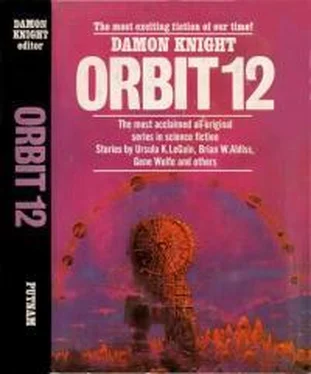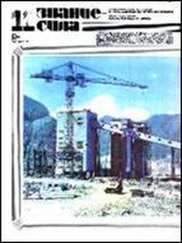Дэймон Найт - Orbit 12
Здесь есть возможность читать онлайн «Дэймон Найт - Orbit 12» весь текст электронной книги совершенно бесплатно (целиком полную версию без сокращений). В некоторых случаях можно слушать аудио, скачать через торрент в формате fb2 и присутствует краткое содержание. Жанр: Фантастика и фэнтези, на английском языке. Описание произведения, (предисловие) а так же отзывы посетителей доступны на портале библиотеки ЛибКат.
- Название:Orbit 12
- Автор:
- Жанр:
- Год:неизвестен
- ISBN:нет данных
- Рейтинг книги:5 / 5. Голосов: 1
-
Избранное:Добавить в избранное
- Отзывы:
-
Ваша оценка:
- 100
- 1
- 2
- 3
- 4
- 5
Orbit 12: краткое содержание, описание и аннотация
Предлагаем к чтению аннотацию, описание, краткое содержание или предисловие (зависит от того, что написал сам автор книги «Orbit 12»). Если вы не нашли необходимую информацию о книге — напишите в комментариях, мы постараемся отыскать её.
Orbit 12 — читать онлайн бесплатно полную книгу (весь текст) целиком
Ниже представлен текст книги, разбитый по страницам. Система сохранения места последней прочитанной страницы, позволяет с удобством читать онлайн бесплатно книгу «Orbit 12», без необходимости каждый раз заново искать на чём Вы остановились. Поставьте закладку, и сможете в любой момент перейти на страницу, на которой закончили чтение.
Интервал:
Закладка:
Drained, she stopped and entered one of the frequent CMU booths. The door closed over the sounds. She needed to rest. The money she had scrounged and smoothed could buy no ticket now past the watchers in the port, so she used it to open lines to the city’s computers, and they returned to her the power of machines. Their lure was too great, measured against the delay. She had been straining so long at the problem she was working on when she left the Institute that the programs needing to be run sprang out full-grown. She did a minute’s worth of exploration and put a block on the lines so she could not be cut off as soon as her money ran out. It should hold long enough. Into the wells she inserted the data cubes she had carried around for two months. Working submerged her; reality dissolved.
Later, while waiting for more important output, Lais almost idly probed for vulnerability in the city programs, seeking to construct for herself a self-erasing escape route. The safeguards were intricate, but hidden flaws leaped out at Lais and the defenses fell, laying the manager programs open to her abilities. It was hardly more difficult than blocking the lines. At that moment she could have put glitches in the city’s services and untraceable bugs in its programs. She could see a thousand ways to disrupt things for mere annoyance, she could detour garbage service and destroy commercial records and mismatch mail codes and reroute the traffic, and there were a thousand times a thousand ways to disrupt things destructively, to turn a community of a million people into the ruined inhabitants of a chaotic war zone. Entropy was all on her side. Yet when the city was stretched out vulnerable before her, the momentary eagerness to destroy left her. The fact that she could have done it seemed to be enough. Taking vengeance on the plastic people would have been senseless and very much like experimenting with mice or rabbits or lower primates, small furry stupid beasts that accept the pain and degradation with frightened resignation in their wide deep eyes, not knowing why. The emotional isolation that might have allowed her to tamper with the city was shattered in her own experience and existence as a laboratory animal, knowing, but not really understanding why.
She slammed at the terminal to close down the holes she had made in the city’s defenses and touched it more gently to complete her work. She used an hour of computer time in less than an hour of real time.
The results came chuckling out: first one, then a second world ecosystem map in fluorescent colors, shading through the spectrum from violet for concrete through blue and green and yellow for high to low certainty to orange and red for theoretical projections. The control map was mostly blue, very little red: it looked good. Its data had been nothing but a sample of ordinary dirt, analyzed down to its isotopes, from the grounds of the outpost where Lais had been working when she got sick. The map showed the smooth flow of natural evolution, spotted here and there with the quick jumps and twists and bare spots and rootless branches of alien human occupation. Its accuracy was extraordinary. Lais had not thought herself still capable of elation, but she was smiling involuntarily, and for a few moments she forgot about pain and exhaustion.
The second map had less blue and more red, but it seemed unified and logical. Its data had been a bit of a drone sample from an unexplored world, and it showed that the programs were very likely doing what they were supposed to do: deduce the structure and relationships of a world’s living things.
Lais’ past research had produced results that could hardly be understood, much less used, by normals. It would be extended and built on by her own kind, eventually, not in her lifetime, or perhaps not even in the lifetime that should have belonged to her. This time she had set out to discover the limits of theory applied to minimal data, and the applications were not only obvious but of great potential benefit. When the hounds tracked her, they would find her last programs, and they would be used. Lais shrugged. If she had wanted to be vindictive, she would have tried not to finish, but her mind and her curiosity and her need for knowledge were not things she could flick on and off at will, to produce results like handfuls of cookies.
The screen blinked. Her time had run out long since, and the computer was beginning to cut out the obstructions she had put in its billing mechanism. But they held for the moment, and the computer began obediently to print out the data blocks after the map and the programs. She reached to turn it off, then drew her hand back.
Among crystal structures and mass spectrum plots a DNA sequence zipped by, almost unnoticed, almost unnoticeable, but it caught her attention. She thought it was from the drone sample. She brought it back and put it on the screen. The city computers had all the wrong library programs, and who bothered to translate DNA anymore anyway? She picked a place that looked right and did it by memory; for Lais it was like typing. AUG, adenine, uracil, guanine. Start: methionine. Life is the same all over. The computer built a chain of amino acids like a string of pop-beads. 2D valiantly masqueraded as 3D. Lais threw in entropy and let the chain fold up. When it was done she doubled and redoubled it and added a copy of its DNA. The screen flickered again; the openings she had made in the computers safeguards were beginning to close, and alarms would be sounding.
The pieces on the screen began the process of self-aggregation, and when they were done she had a luminous green reproduction, a couple of million times real size, of something that existed on the borders of life. It was a virus, that was obvious. She couldn’t stay and translate the whole genome and look for equivalents for the enzymes it would need. She didn’t really have to. It felt, to all her experience, and memory, and intuition, like a tumor virus. She glanced at the printout again and realized with slow shock, free-fall sensation, that this was from the control data.
There were any number of explanations. Someone could have been using the virus as a carrier in genetic surgery, replacing its dangerous parts with genes that it could insert into a chromosome. They didn’t grow freaks at that outpost, but they might have made the virus stocks that the freaks were infected with when they were no more than one-cell zygotes. Someone could have been careless with their sterile technique, especially if they had not been told what the virus was used for and how dangerous it was.
The looming green virus particle, as absurd and obscene that size as the magnified head of a fly, dimmed. The computer was almost through the block. Lais had been in the company of machines so long that they seemed to have as much personality as people; this one muttered and grumbled at her for stealing its time. It lumbered to stop her, a hippopotamus playing crocodile.
Lais had dug the virus up outside in the dirt, free, by chance, and there was a lot of it. If it were infectious—and it seemed complete—it could be infecting people at and around the outpost, not very many, but some, integrating itself into their chromosomes, eradicating the effects of clean-gening. It might wait ten or fifteen or fifty years, or forever, but when injury or radiation or carcinogen induced it out, it would begin to kill. It would be too late to cure people of it then, just as it was for Lais; the old, crippling methods—surgery, radiation—might work for a few, but if the disease were similar to hers, fast-growing, metastasizing, nothing would be much use.
The light on the screen began to go out. She moved quickly and stored the map programs, the maps, the drone data.
She hesitated. In a moment it would be too late. She felt the vengeful animals of memories trying to hold her back. She jabbed with anger at the keyboard and sent the control data into storage with the rest as the last bright lines faded from the screen.
Читать дальшеИнтервал:
Закладка:
Похожие книги на «Orbit 12»
Представляем Вашему вниманию похожие книги на «Orbit 12» списком для выбора. Мы отобрали схожую по названию и смыслу литературу в надежде предоставить читателям больше вариантов отыскать новые, интересные, ещё непрочитанные произведения.
Обсуждение, отзывы о книге «Orbit 12» и просто собственные мнения читателей. Оставьте ваши комментарии, напишите, что Вы думаете о произведении, его смысле или главных героях. Укажите что конкретно понравилось, а что нет, и почему Вы так считаете.


